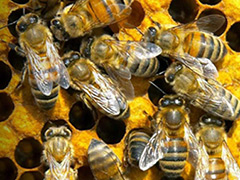Colony Collapse Disorder Follow-Up
Oct 04

This is all well and good, but perhaps because the blogosphere is now so flooded with concern, it seems as if there almost too much information out there (credible or not). An early and ridiculous theory suggested that honeybees were getting lost and confused by cellphone signals. It’s true, however, that there is no one cause for colony collapse disorder.
Walsh rightly stresses the severity of the situation and cites a combination of biological threats (Varroa mites) and man-made damage writing, “As our farms become monocultures of commodity crops like wheat and corn — plants that provide little pollen for foraging bees — honeybees are literally starving to death. If we don't do something, there may not be enough honeybees to meet the pollination demands for valuable crops. But more than that, in a world where up to 100,000 species go extinct each year, the vanishing honeybee could be the herald of a permanently diminished planet.”
Either way, the causes and potential solutions for CCD is not a static subject. And, in the spirit of The Guardian’s ongoing discussion forum, we will continue to provide more articles and information about this pressing matter as the dimensions of the issue expand and evolve. Be sure to check back.
Sources:
http://content.time.com/time/magazine/article/0,9171,2149141,00.html
http://q-and-a.theguardian.com/qanda/1507001




